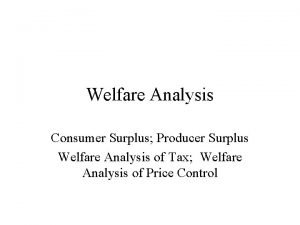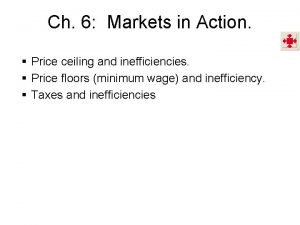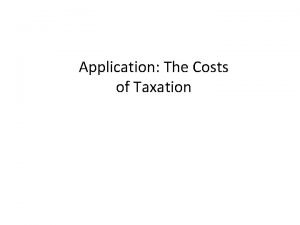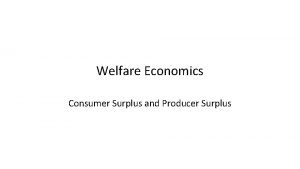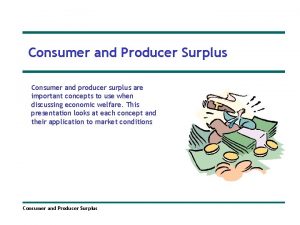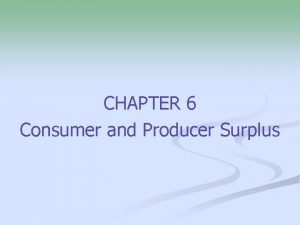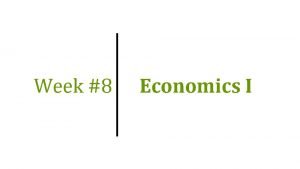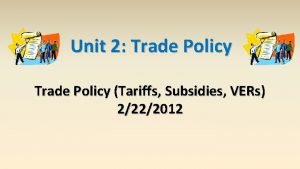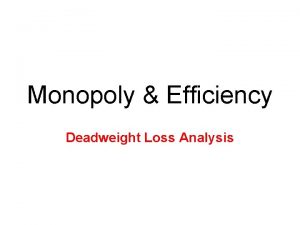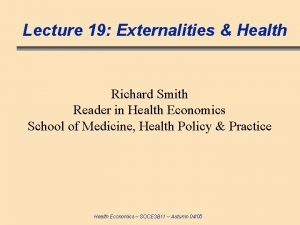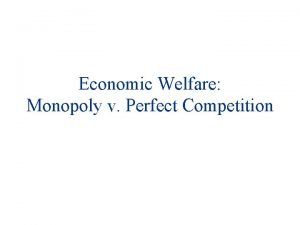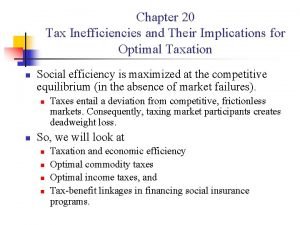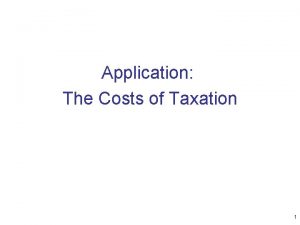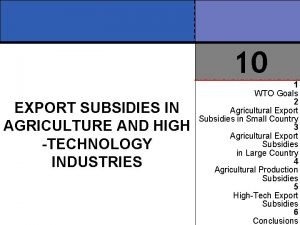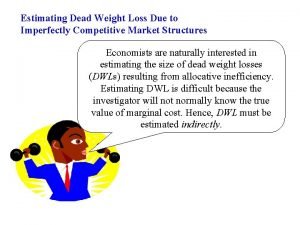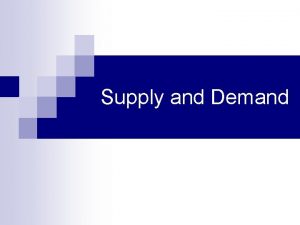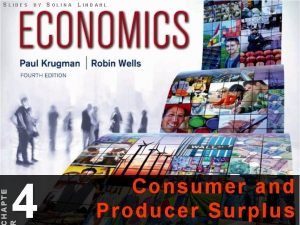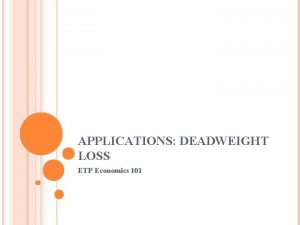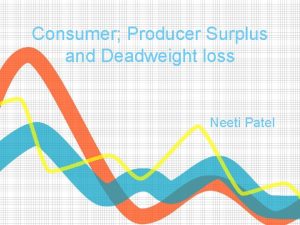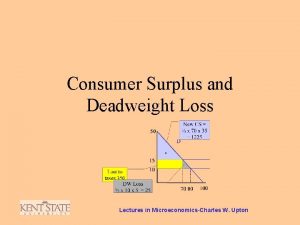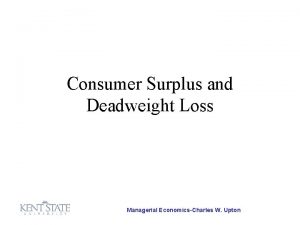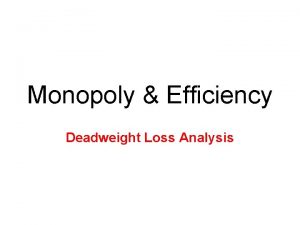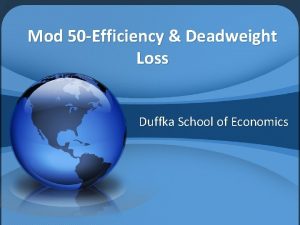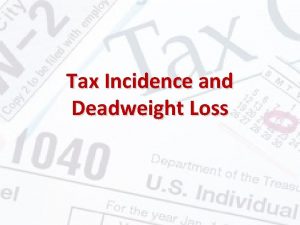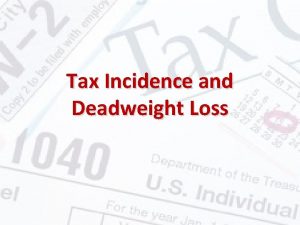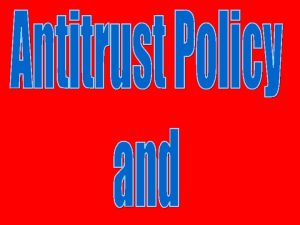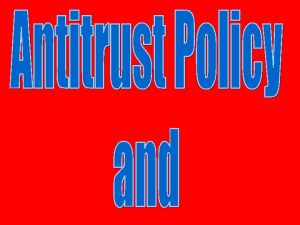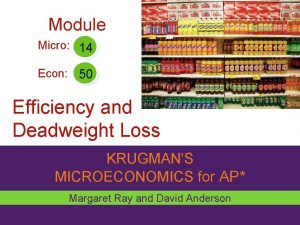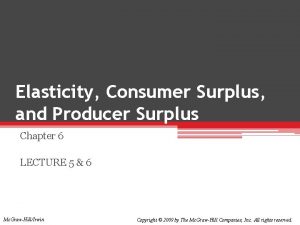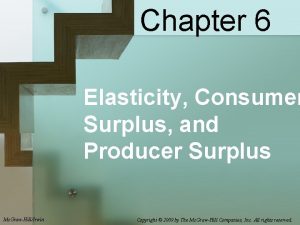SURPLUS EFFICIENCY DEADWEIGHT LOSS SURPLUS EFFICIENCY AND DEADWEIGHT


























- Slides: 26

SURPLUS, EFFICIENCY, & DEADWEIGHT LOSS

SURPLUS, EFFICIENCY, AND DEADWEIGHT LOSS Original slides created by Daniel Forsberg SURPLUS, EFFICIENCY, & DEADWEIGHT LOSS Chapter #5 KENNESAW STATE UNIVERSITY | COLES COLLEGE OF BUSINESS

SURPLUS, EFFICIENCY, AND DEADWEIGHT LOSS GOALS Continuing our examination of the interaction of buyers and sellers in a market, determine who benefits from trade in a market (and to what degree). More precisely, answer the following: 1. How much does a buyer gain from making a purchase? 2. How much does a seller gain from making a sale? 3. In total, how much do buyers and sellers collectively gain from trade in a particular market? 4. In total, how much does society as a whole gain from trade in a particular market? KENNESAW STATE UNIVERSITY | COLES COLLEGE OF BUSINESS

SURPLUS, EFFICIENCY, AND DEADWEIGHT LOSS NEGATIVE-SUM, ZERO-SUM, & POSITIVE-SUM ENVIRONMENTS • Negative-sum environment – a situation in which the sum of gains and losses over all people is negative in value • Zero-sum environment – a situation in which the sum of gains and losses over all people is equal to zero in value • Positive-sum environment – a situation in which the sum of gains and losses over all people is positive in value KENNESAW STATE UNIVERSITY | COLES COLLEGE OF BUSINESS

SURPLUS, EFFICIENCY, AND DEADWEIGHT LOSS Example: consider a coin toss… (assume no pleasure from gambling) 1. Heads: I lose $5 and you win $5… Tails: I win $3 and you lose $3… • ZERO-SUM 2. Heads: I lose $10 and you win $8 ($2 is burned)… Tails: I win $7 and you lose $9 ($2 is burned)… • NEGATIVE-SUM KENNESAW STATE UNIVERSITY | COLES COLLEGE OF BUSINESS

SURPLUS, EFFICIENCY, AND DEADWEIGHT LOSS Win-Win Outcome: • an outcome for which all Win-Lose Outcome: • an outcome for which some people are better off than they are better off and some people are would have been if the worse off than they would have outcome was not realized (i. e. , been if the outcome was not everybody “wins”). realized (i. e. , some people “win” but other people “lose”). KENNESAW STATE UNIVERSITY | COLES COLLEGE OF BUSINESS

SURPLUS, EFFICIENCY, AND DEADWEIGHT LOSS A win-win outcome is only possible in a positive sum environment. • that is, we cannot realize a win-win outcome in either a zero sum or negative sum environment But, being in a positive sum environment does not guarantee that we will realize a win-win outcome • that is, we could realize a win-lose outcome even in a positive-sum environment KENNESAW STATE UNIVERSITY | COLES COLLEGE OF BUSINESS

SURPLUS, EFFICIENCY, AND DEADWEIGHT LOSS Voluntary trade in free markets… • results in a win-win outcome in that buyers and sellers are both better off than they would have been if trade did not occur • intuition: nobody is forcing anyone to trade => if someone was made worse off as a result of a trade, they could simply “veto” the transaction (and refuse to trade) KENNESAW STATE UNIVERSITY | COLES COLLEGE OF BUSINESS

SURPLUS, EFFICIENCY, AND DEADWEIGHT LOSS GAINS FROM TRADE IN A MARKET Recall the “vertical interpretation of curves”… • start by focusing on a particular quantity demanded (or supplied), and then go up to the curve vertically to determine the corresponding price at which this particular quantity would be demanded (or supplied) KENNESAW STATE UNIVERSITY | COLES COLLEGE OF BUSINESS

SURPLUS, EFFICIENCY, AND DEADWEIGHT LOSS Also recall… Buyer’s Reservation Price – maximum dollar amount a buyer is willing to give up in order to acquire an item • At any particular quantity demanded, the height of the demand curve illustrates the “reservation price” of the buyer of that unit. Seller’s Reservation Price – minimum dollar amount a seller is willing to accept in order to part with an item • At any particular quantity supplied, the height of the supply curve illustrates the “reservation price” of the seller of that unit. Our measures of “benefits (or surplus) from trade” will be based upon these reservation prices… KENNESAW STATE UNIVERSITY | COLES COLLEGE OF BUSINESS

SURPLUS, EFFICIENCY, AND DEADWEIGHT LOSS CONSUMER’S SURPLUS & PRODUCER’S SURPLUS • The transfer of ownership of the item by itself (i. e. , for now, not worrying about the money that is trading hands) makes the buyer $22 better off and makes the seller $12 worse off => sum of gains/losses is $22–$12 = $10 => positive-sum environment KENNESAW STATE UNIVERSITY | COLES COLLEGE OF BUSINESS

SURPLUS, EFFICIENCY, AND DEADWEIGHT LOSS Consumer’s Surplus: When a buyer purchases an item for less than his reservation price he obtains a “gain” or “surplus” from doing so. Producer’s Surplus: When a producer sells an item for more than her reservation price she obtains a “gain” or “surplus” from doing so. KENNESAW STATE UNIVERSITY | COLES COLLEGE OF BUSINESS

SURPLUS, EFFICIENCY, AND DEADWEIGHT LOSS SOCIAL SURPLUS Social Surplus: The Social Surplus of a trade is equal to the sum of gains over every person in society • For many goods, people other than buyer/seller have a surplus of (0) => Social Surplus is simply the sum of Consumer’s Surplus and Producer’s Surplus: • • Note, price complete drops out of the expression for Social Surplus Price at which trade takes place is critical for determining how the gains from trade are split between the trading partners, but does not influence the magnitude of Social Surplus whatsoever. KENNESAW STATE UNIVERSITY | COLES COLLEGE OF BUSINESS

HOW A MARKET SYSTEM FUNCTIONS Recall, properties of market equilibrium • • • stable – if we are there we will stay there, unless outside forces change (but this had to be true by the definition of equilibrium) unique – there is one and only one equilibrium (a property which follows from the “Law of Demand” and “Law of Supply”) self-enforcing – at higher prices there is downward pressure on price; at lower prices there is upward pressure on price (therefore if we start at any other price, we will be pushed toward the equilibrium price) KENNESAW STATE UNIVERSITY | COLES COLLEGE OF BUSINESS

HOW A MARKET SYSTEM FUNCTIONS But is the equilibrium outcome a “desirable outcome”? What is the “best level of trade” for society? If we place equal weight on the well-being of all people, we can address this question by comparing “Total Social Surplus” at the market equilibrium to “Total Social Surplus” at other levels of trade… KENNESAW STATE UNIVERSITY | COLES COLLEGE OF BUSINESS

SURPLUS, EFFICIENCY, AND DEADWEIGHT LOSS TOTAL SURPLUSES • • • Total Consumers’ Surplus – a measure of the total gains from trade realized by consumers, defined as the difference between buyer’s reservation price and actual price paid added over all units purchased. Total Producers’ Surplus – a measure of the total gains from trade realized by sellers, defined as the difference between actual price received and seller’s reservation price added over all units sold. Total Social Surplus – a measure of the total gains from trade, defined as the sum of Total Consumers’ Surplus and Total Producers’ Surplus in the market. KENNESAW STATE UNIVERSITY | COLES COLLEGE OF BUSINESS

SURPLUS, EFFICIENCY, AND DEADWEIGHT LOSS TOTAL SURPLUS MAXIMIZATION Recall, Social Surplus from trading one particular unit: To maximize Total Social Surplus, which units should be traded and which units should not be traded? KENNESAW STATE UNIVERSITY | COLES COLLEGE OF BUSINESS

SURPLUS, EFFICIENCY, AND DEADWEIGHT LOSS TOTAL SURPLUS MAXIMIZATION To maximize Total Social Surplus… Total Social Surplus is maximized by trading all units and only those units for which buyer’s reservation price exceeds seller’s reservation price. KENNESAW STATE UNIVERSITY | COLES COLLEGE OF BUSINESS

SURPLUS, EFFICIENCY, AND DEADWEIGHT LOSS EFFICIENCY OF EQUILIBRIUM • • The Equilibrium Quantity of Trade is Efficient in the sense that it maximizes Total Social Surplus (i. e. , total gains from trade). Any other level of trade is Inefficient in the sense that Total Social Surplus is not as large as possible. § Any other level of trade (either higher or lower than the equilibrium) leads to a smaller value of Total Social Surplus. KENNESAW STATE UNIVERSITY | COLES COLLEGE OF BUSINESS

SURPLUS, EFFICIENCY, AND DEADWEIGHT LOSS NOTE: To say that “free markets” are efficient is a bit of a simplification. In practice, several conditions must be met for this to be true, including… § § § there must be many buyers and many sellers in the market information must be available to market participants at low cost there cannot be any “external effects” associated with production/consumption of the good KENNESAW STATE UNIVERSITY | COLES COLLEGE OF BUSINESS

SURPLUS, EFFICIENCY, AND DEADWEIGHT LOSS The Deadweight Loss (DWL) – the difference between the maximum possible level of Total Social Surplus and the realized level of Total Social Surplus. • DWL is zero at the efficient level of trade • DWL is positive at all other levels of trade • By definition, DWL is never negative KENNESAW STATE UNIVERSITY | COLES COLLEGE OF BUSINESS

SURPLUS, EFFICIENCY, AND DEADWEIGHT LOSS INEFFICIENCY FROM TOO LITTLE TRADE Inefficiency from “too little trade” – there are some units that we do not trade for which buyer’s reservation price is greater than seller’s reservation price • we do not trade all of the units we should trade KENNESAW STATE UNIVERSITY | COLES COLLEGE OF BUSINESS

SURPLUS, EFFICIENCY, AND DEADWEIGHT LOSS INEFFICIENCY FROM TOO MUCH TRADE Inefficiency from “too much trade” – we trade some units for which seller’s reservation price is greater than buyer’s reservation price • we trade some units that we should not trade Open-ended fallacy – the logical error whereby someone incorrectly concludes that simply because there are benefits (to some people) from higher levels of an activity, that more of the activity is always better KENNESAW STATE UNIVERSITY | COLES COLLEGE OF BUSINESS

SURPLUS, EFFICIENCY, AND DEADWEIGHT LOSS SOCIALLY BEST LEVEL OF TRADE Important to recognize that whatever the good, the socially best level of production/consumption is finite… • direct result of scarcity of resources => tradeoffs exist in regards to levels of production of different goods • to maximize Total Social Surplus, appropriately compare and balance marginal benefits for society against marginal costs for society (exactly as suggested by Cost-Benefit Principle) Notice that the entire discussion of efficiency and Deadweight Loss made no mention whatsoever of price… KENNESAW STATE UNIVERSITY | COLES COLLEGE OF BUSINESS

SURPLUS, EFFICIENCY, AND DEADWEIGHT LOSS ROLE OF EQUILIBRIUM PRICE While price does not play any role in determining the “total gains from trade, ” it is of critical importance in specifying how the “total gains” are “split” between buyers and sellers. • at the market equilibrium outcome, Equilibrium Price “splits” the “total gains from trade” between buyers and sellers… KENNESAW STATE UNIVERSITY | COLES COLLEGE OF BUSINESS

SURPLUS, EFFICIENCY, & DEADWEIGHT LOSS
 Price ceiling and deadweight loss
Price ceiling and deadweight loss Binding price floor
Binding price floor Tax revenue and deadweight loss graph
Tax revenue and deadweight loss graph Producer
Producer Consumer surplus and producer surplus
Consumer surplus and producer surplus Producer and consumer surplus graph
Producer and consumer surplus graph Deadweight loss in a monopoly
Deadweight loss in a monopoly 2222012
2222012 Positive externality deadweight loss
Positive externality deadweight loss Positive externality deadweight loss
Positive externality deadweight loss P = mc
P = mc Deadweight loss in positive externality
Deadweight loss in positive externality X efficiency monopoly
X efficiency monopoly Deadweight loss formula
Deadweight loss formula Deadweight loss tax
Deadweight loss tax Deadweight loss tariff
Deadweight loss tariff Perfectly price discriminating monopoly
Perfectly price discriminating monopoly Subsidy deadweight loss
Subsidy deadweight loss Monopoly graph deadweight loss
Monopoly graph deadweight loss Deadweight loss formula
Deadweight loss formula Difference between normal loss and abnormal loss
Difference between normal loss and abnormal loss Productive inefficiency and allocative inefficiency
Productive inefficiency and allocative inefficiency Allocative efficiency vs productive efficiency
Allocative efficiency vs productive efficiency Productive inefficiency and allocative inefficiency
Productive inefficiency and allocative inefficiency How to find producer surplus
How to find producer surplus Surplus shortage graph
Surplus shortage graph When are consumer and producer surplus maximized?
When are consumer and producer surplus maximized?
